A SUMMARY OF THE ARCHDIOCESE OF KAUNAS
Two Papal visits in twenty-five years
In September of 1993, the Archdiocese of Kaunas, along with the rest of Lithuania, was honored by the first visit of a Holy Father. St. John Paul II on his apostolic journey to the Baltic States visited, encouraged and blessed Lithuania on taking its first steps of Independence. At Santaka in Kaunas, the Pope celebrated Holy Mass, met with youth from all over Lithuania, prayed in private at the Archcathedral Basilica, and met and dined with all of Lithuania‘s bishops at the curia. 25 years later, on September 23rd, Holy Father Francis will celebrate Holy Mass at Santaka Park, on St. John Paul II Hill in Kaunas. The slogan for his visit to the Baltic States is: „Jesus Christ – Our Hope.“ (1 Tim 1:1)
Facts and Figures
The Archdiocese of Kaunas was established in 1926. Prior to that, it was part of the Samogitian Diocese. The Diocese of Telsiai, Vilkaviskis and Siauliai are also part of Kaunas‘ metropolis. St. John the Baptist is the heavenly patron. The Baptism of Christ is depicted in the symbol of the Archdiocese.
Since July 11th, 2015 the Archdiocese is under the leadership of Kaunas Metropolitan Archbishop Lionginas Virbalas SJ, appointed by Pope Francis. On July 2nd, 2018 Pope Francis nominated Monsignor Algirdas Jurevicius as Bishop Auxiliary.
Emeritus Sigitas Tamkevicius SJ was the leader of the Archdiocese for 20 years, from 1996-2015. He actively defended religious freedom and the Church during the years of Soviet persecution, was the editor of the underground publication The Chronicle of the Catholic Church in Lithuania and is a former political prisoner. On January 13th, 2014 he received the Freedom Award presented at the Parliament of the Republic of Lithuania.
Approximately 425,000 people live in the territory of the Kaunas Archdiocese (~8.75 km²). About 33,000 people of faith attend Holy Mass every Sunday. (~10% of Catholics).
In 2017, 4,023 infants and children and 319 adults were Baptized. First Holy Communion was received by 3,236 children. The Sacrament of Confirmation was received by 1,786 people. The Sacrament of Holy Matrimony was received by 1,444 couples. 5,824 people had Catholic burials.
There are 92 active parishes and 13 rectorates, monasteries and non-parish churches in the Archdiocese. Over 120 priests serve the faithful. Of those, 20 are in orders (Jesuit, Capuchin, Carmelite, Marian and Franciscan).
Almost 200 nuns belong to the 13 congregations, whose convents are within the territory of the Archdiocese.
The Priest‘s Seminary in Kaunas is 150 years old, and prepares future priests for the Kaunas Archdiocese and Siauliu and Vilkaviskio dioceses.
Since 2011, a Deacon‘s Educational Center was established in the Archdiocese, where laymen are prepared for the deaconhood. On June 24th, 2017 five married laymen were ordained as deacons. This was the first ordination in Lithuania.
The Theology Department at Vytautas Magnus University in Kaunas offers studies in family and marriage and Church history.
There are also various pastoral care institutions within the Archdiocese, including: Caritas, Catechesis, Youth and Family centers, St. John Paul II Pilgrim‘s Center and an Adult Catechism Office. Their work encorporates religious education, parish catechism, Catholic youth education, pastoral care for engaged couples and families, volunteer and pilgrim instruction. The organizations and programs also help society solve family problems, free time and rearing issues of the youth. Participants are also encouraged to be concerned with the weakest members.
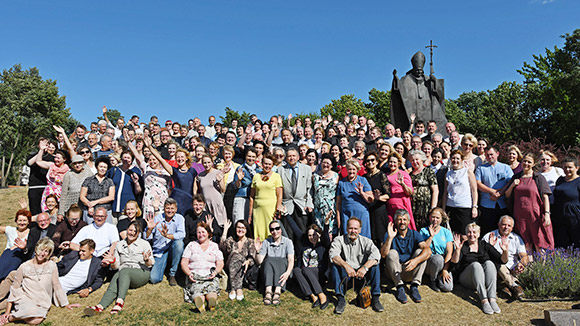
In the last decade, positive changes have been noticed in the life of the Archdiocese. There are increasing numbers of young people and families, and also more responsibility in parishes, institutions and organizations. The preparation for sacraments is viewed more seriously, there is more effort to participate in the liturgy, to get involved in the community, share the faith, and from its foundations, create community ties. Though demographics have been affected by emigration, and has affected the number of Catholics, the goal is to lead an authentic Christian life.
For many years, ecumenical ties have existed in the Archdiocese. Christian churches and communities, especially traditional ones such as: Orthodox, Evangelical Lutheran and Evangelical Reformed annually join in the Prayer for Christian Unity Week and also gather for ecumenical service in Kaunas, Siluva and Kedainiai.
The Wounds of Soviet Occupation
The years before World War II, and almost 50 years of Soviet occupation after were marked by the persecution and oppression of the clergy and believers, restrictions on Church activities and propogation of atheistic ideology. There were many challenges for the Archdiocese of Kaunas, as well as the entire Church in Lithuania, during those 50 years of Soviet occupation.
In 1940, when the Soviet Army occupied Lithuania, the new government announced the separation of Church from State. Shortly thereafter, the concordat with the Vatican was unilaterally severed. The Apostolic Nuncio was ordered to leave without delay. The Church was removed from public life. Religious education was forbidden in schools. Catechism was not allowed for children. All religious press was closed, all male and female orders were dissolved, the activities of all Catholic organizations were stopped, all Church and religious organization property was nationalized, Catholic schools, kindergartens and nursing homes were closed. Chaplains were removed from the army, schools and prisons. Oppression began against priests to scare them.
In1944, as the Red Army was approaching, the shepherds of the Kaunas Archdiocese, Archbishop Juozapas Skvireckas and Bishop Vincentas Brizgys, were forced to flee to the West. Along with them, 73 priests left the Archdiocese. The years after the war were especially difficult. From Kaunas alone, where there were 70 priests at the time, 50 were sent into exile. Deaconates were reduced to 6 (there were 10 previously). The possibilities for providing some religious services were very limited, and that included teaching children religion. Oppression against priests began to intensify. By 1951, 58 priests from the Archdiocese were arrested and tried.
Many churches were closed and were used for manufacturing, production, or some other purpose. Those included: St. Francis Xavier (Jesuit), St. George‘s (Franciscan), Holy Trinity (seminary), St. Gertrude‘s (Marian), St. Nicholas (Benedictine), St. Michael the Archangel (garrison), St. Joseph‘s in Kedainiai, and other churches (23 in total).
Once the seminaries in Telsiai and Vilkaviskis were closed, only the Priest‘s Seminary in Kaunas remained. The number of clerics was constantly decreasing, as there were obstacles created for those wanting to get in.

Male and female orders received a painful blow in the Archdiocese as they were forced to move underground. The nuns in the Archdiocese, as in the rest of Lithuania, secretly taught Catechism to children and adults, and would also apostolize, despite the conditions.
Kaunas was the center of the underground resistance to the Soviet government. The activities focused on the persecution of the Church and the faith. The Chronicle of the Catholic Church in Lithuania and other religious literature was distributed from there. Kaunas had an underground printing facility, where a Eucharistic fellowship group would meet.
The dawn of freedom
As the Soviet Union was collapsing, democratic processes were intensifying, and signs of increasing religious freedom were noticed in the late 1980‘s.
With the dawn of freedom from 1988–1989, the Kaunas Archdiocese met with painful injuries. But as the first winds of freedom were felt, the obstacles that restricted Church activity were torn down, a dynamic rebirth began and communities were being renewed.
Property that was confiscated by the Soviets was gradually being returned to the Kaunas Archdiocese, as well as the rest of the Church in Lithuania. Religious education was allowed once again in schools. There were new possibilities for charitable, evangelizing, cultural and informational activities. There was a revival of old Church organizations, as well as the establishment of new ones including: new offices and departments. Secularized, contemporary pastoral care which met the needs of society was expanding, in addition to evangelization, catechesis and financial aid initiatives. Historical and other factors determined that there were quite a few inter-diocesan offices and centers in Kaunas.
The Most Popular Pilgrimage Sites
Siluva
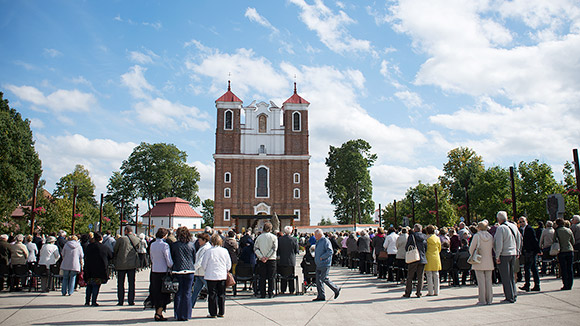
The main pilgrimage shrine in the Archdiocese is Siluva (a small town in Raseiniai). In 1608, Holy Mother Mary appeared there, and asked that her Son be worshipped at that site where there once stood a church. It was destroyed during the Reformation. Only working fields were left. This apparition was seen by an Evangelical Reformed catechist, among other non-Catholics. Today Siluva is a contemporary pilgrimage center adapted for pilgrim‘s needs.
Pope John Paul II visited Siluva in September 1993 during his apostolic visit. Siluva attracts tens of thousands of pilgrims annually, not only from Lithuania, but also from neighboring countries. This has been happening for 500 years, especially during the celebration of the birth of Mary.
The tradition of pilgrimages to Siluva has been known since the 17th c., and was being restricted in many ways during Soviet times. The processions of the prayerful and the organizers experienced persecution. Crowds of pilgrims came to Siluva to pray for freedom for the homeland. Pilgrims who come to Siluva these days are grateful for freedom, pray for Lithuania and its people, ask for physical and spiritual healing from the Mother of God, health for the sick and intercession. They pray to the 300 year old painting of our Holy Mother Mary and the Divine Child which is protected at the Basilica of the Nativity of our Blessed Virgin Mary. This icon is known for extending graces and was restored in 2003. It was covered in crowns by the Pope, and is connected to the Mary of the Snows (Salus populi romani) icon in Rome. The site of Holy Mary‘s apparition is marked by the magnificent Visitation Chapel with a rock, which is believed to have been touched by the Blessed Mother‘s feet.
The Archcathedral Basilica in Kaunas

The Archcathedral Basilica of St. Peter and Paul is at the heart of the Old Town in Kaunas. This magnificent sanctuary is the heart of the Archdiocese. The throne of the archbishop is found there. Duke Vytautas the Great established the Church of St. Peter in Kaunas. That was one of three most important sanctuaries and most important Catholic sanctuary in Kaunas. The other two were St. Nicholas and the Assumption of the Blessed Virgin Mary. St. Peter‘s became the deaconate center in Kaunas, part of the Vilnius Diocese at the beginning of the 17th c. It received the title of Cathedral (with the bishop‘s throne) in 1895 by Pope Leo XIII.
On the 500th anniversary of the establishment of the Samogitian Diocese in 1921, Pope Benedict XV gave the Cathedral the title of Basilica. In 1926, Lithuania‘s Church Province was established, and then the Basilica became an Archcathedral with the throne of the Archbishop Metropolitan.
At the dawn of Lithuania‘s rebirth in 1989, newly nominated Archbishop Vincentas Sladkevicius MIC entered the Archcathedral Basilica after many centuries as a Cardinal.
On September 6th,1993 the Holy Father John Paul II privately visited the Archcathedral. His visit is remembered with a memorial plaque. Cardinal Archbishop Stanisławas Dziwiszas, personal secretary to John Paul II for many years, gifted a relic of St. John Paul II to the Archcathedral in 2013, commemorating its 600 year anniversary. It is located at the side altar.
It is the only basilican gothic church in the country. Famous members of the clergy are buried in the crypt, chapel or churchyard of the Archcathedral.
Pazaislis Church and Monastery

Pazaislis Church of the Visitation of the Blessed Virgin Mary and Monastery Complex is one of the older baroque architectural masterpieces in Northeastern Europe. It was constructed on the riverside of the Kaunas Reservoir on Pazaislis Hill. Chancellor Kristupas Zygimantas Pacas of Lithuania‘s Grand Duchy founded this monastery and housed Camaldolese monks there. The Italian architect Giovanni Batista Frediano designed the complex. It is decorated with moldings made by sculptors from Lombardia, and frescoes by the Florentine painter Michael Archangel Palonio. Pazaislis is famous for the painting of the Camaldolese Mother of God which is over the great altar. The painter is unknown.
During the years of Czarist occupation, the Camaldolese monks were moved to various monasteries in the Mogilev region, and the Orthodox Uspensija Monastery was established at Pazaislis. From 1917–1918, the Germans transformed the space into a kaiser‘s army hospital.
In 1921, the government transferred the abandoned Pazaislis Monastery to the Sisters of St. Casimir Congregation from Chicago. In 1948, the Soviet Government ordered the nuns to move out of the monastery and end any activity there. During the Soviet years, the structures at the complex were used for government archives, a tourist base, psychiatric hospital, and later became a branch of the National M.K. Ciurlionis Museum.
In 1992, the Pazaislis Monastery was returned to the Sisters of St. Casimir Congregation. Pilgrims and the prayerful visit Pazaislis from all over Europe asking for blessings and give thanks for them.
Resurrection Basilica

During the time of Lithuanian Independence in between wars, in 1926, under the initiative of Juozapas Skvireckas Archbishop Metropolitan of Kaunas, it was decided to build a church in Kaunas—a symbol of the resurrection of Lithuania as thanks to the Almighty for regained independence. The magnificent building was almost completed in the spring of 1940. The construction was halted during the first Soviet occupation. The Soviet Government nationalized the structure and converted it into a radio production factory.
After the restoration of Independence in Lithuania, the construction work was continued, healing the Soviet inflicted wounds to the Church. The first Holy Mass was celebrated in 1997. The dedication of the sanctuary took place in 2004, surrounded by scaffolding. In 2015, Pope Francis designated the church as a basilica.
Prominent Individuals
The Blessed Jurgis MATULAITIS (1871–1927)
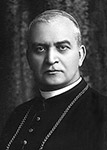 On December 1st, 1918 he was consecrated as Bishop at the Kaunas Cathedral, and was assigned as leader of the Vilnius Diocese. During the last years of his life, the Blessed Archbishop Matulaitis MIC lived and worked in Kaunas where he prepared a project dealing with the provinces of the Church in Lithuania. He especially helped to improve Lithuania‘s relations with The Holy See, and was deeply involved with preparing the concordat.
On December 1st, 1918 he was consecrated as Bishop at the Kaunas Cathedral, and was assigned as leader of the Vilnius Diocese. During the last years of his life, the Blessed Archbishop Matulaitis MIC lived and worked in Kaunas where he prepared a project dealing with the provinces of the Church in Lithuania. He especially helped to improve Lithuania‘s relations with The Holy See, and was deeply involved with preparing the concordat.
The Blessed Teofilius MATULIONIS (1873–1962)
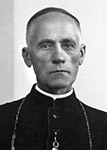 Upon his return from Russia in 1936, until he was assigned as Bishop of Kaisiadorys in 1943, Bishop Teofilius Matulionis assisted Archbishop J. Skvireckas with pastoral care in the Archdiocese. He was assigned as rector of St. Nicholas Church in Kaunas (Benedictine) and chaplain of the Benedictine Sisters Convent. He started the continuous adoration of the Blessed Sacrament, and was assigned as the Senior Chaplain in the Lithuanian Army. While living in Kaunas, he continued to take care of missions in Russia.
Upon his return from Russia in 1936, until he was assigned as Bishop of Kaisiadorys in 1943, Bishop Teofilius Matulionis assisted Archbishop J. Skvireckas with pastoral care in the Archdiocese. He was assigned as rector of St. Nicholas Church in Kaunas (Benedictine) and chaplain of the Benedictine Sisters Convent. He started the continuous adoration of the Blessed Sacrament, and was assigned as the Senior Chaplain in the Lithuanian Army. While living in Kaunas, he continued to take care of missions in Russia.
God‘s servants Adele DIRSYTE (1909–1955) and Elena SPIRGEVICIUTE (1924–1944)
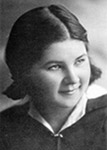 In 2000, the beatification process was started for these women in the Kaunas Archdiocese.
In 2000, the beatification process was started for these women in the Kaunas Archdiocese.
Adele Dirsyte was a Catholic layperson, teacher, member of the Catholic organization Ateitininkai, was exiled, and is the author of the Siberian prisoner prayer book: Mary, Help Us. Was killed or died returning to Lithuania from the prison camp in Chabarovsk. The circumstances of her death are still unknown, nor the burial place. Received the Order of the Cross of Vytis 4th Class posthumously in 1999.
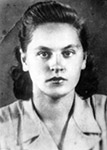 Elena Spirgeviciute was a Catholic layperson, witness to the faith, a scout, and died defending her chastity. She sacrificed her life for her faith, honor and dignity.
Elena Spirgeviciute was a Catholic layperson, witness to the faith, a scout, and died defending her chastity. She sacrificed her life for her faith, honor and dignity.
During the celebration of the anniversary of Christianity, together with 30,000 new martyrs of faith in the world and 114 martyrs in Lithuania, both women were included in the 20th c. Church Book of Martyrs.
Other 20th c. Witnesses to the Faith
On May 7th, 2000, these witnesses to the faith from the Archdiocese of Kaunas were announced as new martyrs, and were included in the Book of Martyrs. The event took place at the Coliseum in Rome. The list included:
- Benediktas Andruska (1884–1951), Jesuit priest, died in prison in Siberia;
- Baltramiejus Auglys (1869–1932), layperson, church guard, killed in Russia;
- Petras Auglys (1861–1937), priest, shot and killed in an NKVD prison in Minsk;
- Jonas Burneika (1901–1956), priest, died imprisoned in Siberia;
- Severinas Buteikis (1911–1942), priest, died from injuries received in 1941 while being tortured in Kaunas prison;
- Pranas Dovydaitis (1886–1942), layperson, Doctor of Philosophy, Professor, society activist, died in Sverdlovsk prison;
- Virgilijus Jaugelis (1948–1980), priest who was imprisoned for propogation of faith, in Pravieniskiu prison;
- Petras Kairys (1884–1937), layperson, organist, shot and killed in Russia;
- Petras Paulaitis (1904–1986), layperson, teacher, imprisoned for 30 years for patriotic and religious activity;
- Juozapas Usonis (1867–?), priest, shot and killed in Minsk before World War II;
- Boleslavas Vegele (1880–1941), priest, after being tortured by the NKVD, he was killed near Skaruliai;
- Pranciskus Vitkevicius (1877–1941), priest, shot and killed by the NKVD near Skaruliai.
Archbishop Juozapas SKVIRECKAS (1873–1959)
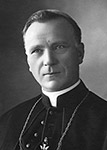 After establishment of the Church Provinces, Pope Pius XI designated Juozapas Skvireckas as Metropolitan Archbishop of the Kaunas Archdiocese on May 4th, 1926. From 1926–1944 he was in charge of the Kaunas Archdiocese. Under his authority, quite a few new churches were built in Kaunas and the provinces, the priest‘s seminary expanded into interdiocesan, etc. One of his greatest works was translating the Holy Bible (both Old and New Testaments) into Lithuanian. From 1944, „ordinaras impedito“ interfered with his ability to continue his pastoral responsibility in Lithuania.
After establishment of the Church Provinces, Pope Pius XI designated Juozapas Skvireckas as Metropolitan Archbishop of the Kaunas Archdiocese on May 4th, 1926. From 1926–1944 he was in charge of the Kaunas Archdiocese. Under his authority, quite a few new churches were built in Kaunas and the provinces, the priest‘s seminary expanded into interdiocesan, etc. One of his greatest works was translating the Holy Bible (both Old and New Testaments) into Lithuanian. From 1944, „ordinaras impedito“ interfered with his ability to continue his pastoral responsibility in Lithuania.
Administrator Prelate Stanislovas JOKUBAUSKIS (1880–1947)
 Since the Archbishop of Kaunas and his assistant left Lithuania, the position of administrator of the Archdiocese was given to Prelate Stanislovas Jokubauskis. He worked in his leadership position until his death in 1947. In 1999, he was given a posthumous award by the United Nations in Jerusalem for saving Jewish children from the ghetto during WWII in Vilijampole. A memorial plaque in his honor was placed near the Kaunas Archcathedral Basilica.
Since the Archbishop of Kaunas and his assistant left Lithuania, the position of administrator of the Archdiocese was given to Prelate Stanislovas Jokubauskis. He worked in his leadership position until his death in 1947. In 1999, he was given a posthumous award by the United Nations in Jerusalem for saving Jewish children from the ghetto during WWII in Vilijampole. A memorial plaque in his honor was placed near the Kaunas Archcathedral Basilica.
Cardinal Vincentas SLADKEVICIUS (1920–2000)
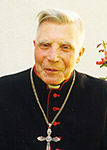 On November 14th, 1957, he was nominated Bishop by Pope Pius XII and assigned as the auxiliary sedidatus to the Bishop of Kaisiadorys. On December 25th,1957, at the rectory in Birstonas, the Bishop of Kaisiadorys Teofilius Matulionis secretly consecrated Vincentas Sladkevicius as a Bishop. The Soviet Government did not allow him to function as a Bishop. He was exiled to Nemunelis‘ Radviliskis (Birzai) in 1959 where he lived until 1976. From 1976-1982, he was transferred to Pabirze by the Civil Government. On June 15th,1982 Bishop Vincentas Sladkevicius became the Apostolic Administrator of the Kaisiadorys Diocese. From 1988–1993 he was the head of the Bishop‘s Conference in Lithuania. On July 28th, 1988, he was designated Cardinal by Pope St. John Paul II. In 1989, he was assigned as Archbishop of Kaunas. He fulfilled his duties until 1995. He passed away on May 28th, 2000, and is buried in the Archcathedral Basilica in Kaunas. In 1993, he was given an Honorary Citizen Award by Kaunas.
On November 14th, 1957, he was nominated Bishop by Pope Pius XII and assigned as the auxiliary sedidatus to the Bishop of Kaisiadorys. On December 25th,1957, at the rectory in Birstonas, the Bishop of Kaisiadorys Teofilius Matulionis secretly consecrated Vincentas Sladkevicius as a Bishop. The Soviet Government did not allow him to function as a Bishop. He was exiled to Nemunelis‘ Radviliskis (Birzai) in 1959 where he lived until 1976. From 1976-1982, he was transferred to Pabirze by the Civil Government. On June 15th,1982 Bishop Vincentas Sladkevicius became the Apostolic Administrator of the Kaisiadorys Diocese. From 1988–1993 he was the head of the Bishop‘s Conference in Lithuania. On July 28th, 1988, he was designated Cardinal by Pope St. John Paul II. In 1989, he was assigned as Archbishop of Kaunas. He fulfilled his duties until 1995. He passed away on May 28th, 2000, and is buried in the Archcathedral Basilica in Kaunas. In 1993, he was given an Honorary Citizen Award by Kaunas.
Prepared by the Archdiocese of Kaunas Information Office











